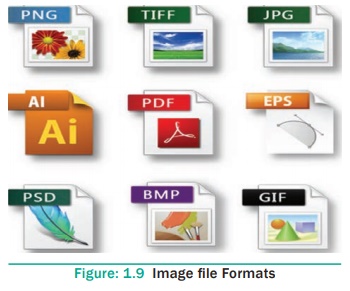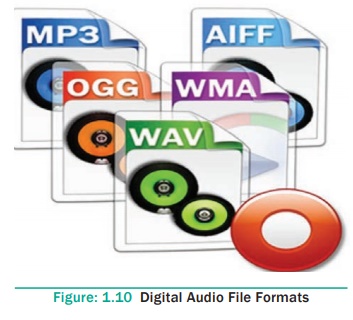Chapter: 12th Computer Applications : Chapter 1 : Multimedia and Desktop Publishing
File Formats for Multimedia
File
Formats for Multimedia
The following is an outline of current file formats
used for the production and delivery of multimedia data.
1. Text Formats
RTF
Rich Text Format is the primary file format
introduced in 1987 by Microsoft with the specification of their published
products and for cross-platform documents interchange.
Plain text
Plain text files can be opened, read, and edited
with most text editors. commonly used are Notepad (Windows), Gedit or nano
(Unix, Linux), TextEdit (Mac OS X) and so on. Plain text is the original and
popular way of conveying an e-mail.
2. Image Formats
TIFF (Tagged Image File Format)
This format is common in desktop publishing world (high quality output), and is supported by almost all software packages. Recent versions of TIFF allows image compression, and the format is comfortable for moving large files between computers.
BMP (Bitmap)
Initially this format is in use with Windows 3.1.
It is quite large and uncompressed and hence BMP is used for the
high-resolution or large images.
DIB (Device Independent Bitmap)
A device independent bitmap contains a colour
table. The colour describes how pixel values corresponds to RGB colour values,
which describes colors that are produced by emitting light.
GIF (Graphics Interchange Format)
GIF is a compressed image format. Most of the
computer color images and backgrounds are GIF files. This file format is best
suitable for graphics that uses only limited colors, and it is the most popular
format used for online color photos. 13-bit Color look up table is used by the
GIF format to identify its color values. This format is supported widely.
JPEG (Joint Photographic Experts Group)
JPEG is a commonly used method of lossy compression
for digital images. The degree of compression can be adjusted and it works good
with photographs, naturalistic artwork, and similar material but functions less
on lettering, live drawings or simple cartoons.
TGA (Tagra)
It is the first popular format for high-resolution
images. TGA files are common in animation video industry.
PNG (Portable Network Graphics)
An extensible file format for the less loss,
portable and well compressed storage of raster images. PNG acts as replacement
for GIF and also replaces multiple common uses of TIFF. PNG works good with
online viewing applications like worldwide web. so it is fully streameable with
a best display option.

3. Digital Audio File Formats
WAV (Waveform Audio File Format)
It is the most popular audio file format in windows
for storing uncompressed sound files. In order to attain the reduced file size
it can also be converted to other file formats like MP3.
MP3 (MPEG Layer-3 Format)
MPEG Layer-3 format is the most popular format for
storing and downloading music. The MP3 files are roughly compressed to
one-tenth the size of an equivalent WAV file.
OGG
A free, open source container format that is
designed for obtaining better streaming and evolving at high end quality
digital multimedia. It can be compared to MP3 files in terms of quality.
AIFF (Audio Interchange File Format)
It is an audio file format developed by Apple Inc.
used for storing sound data for personal computers and other electronic audio
devices.
WMA (Windows Media Audio)
It is a popular windows media audio format owned by
Microsoft. WMA is a file extension used with windows media player.
RA (Real Audio Format)
Real Audio format is designed for streaming audio
over the Internet. The digital audio resources are usually stored as a computer
file in computer’s hard drive or CD/DVD. Besides the variety of audio file
formats available, the most common formats are wave files (.WAV) and MPEG
Layer-3 files (.MP3), WMA and RA.

4. Digital Video File Formats
AVI (Audio/Video Interleave)
AVI is the video file format for Windows. Here
sound and picture elements are stored in alternate interleaved chunks in the
file.
MPEG (Moving Picture Experts Group)
MPEG is a standard for generating digital video and
audio compression under the International Standards Organization (ISO) by the
group of people. The group has developed MPEG- 1, the standard on which Video
CD and MP3 are based, MPEG-2, the standard that supports products as Digital
Television set top boxes and DVD, MPEG-4, the standard for multimedia and
mobile web.MPEG-7, the standard for search of audio and visual content.
Research on MPEG-21 “Multimedia Framework” has started in 2000. Simply MPEG is
the standards for digital video and audio compression.

Related Topics